 Tea in Harlem has been a constant since its early years with the Muscoota Indians in East Harlem to the Harlem Renaissance with Lelia Walker’s Dark Tower on 136th Street in Central Harlem to today.
Tea in Harlem has been a constant since its early years with the Muscoota Indians in East Harlem to the Harlem Renaissance with Lelia Walker’s Dark Tower on 136th Street in Central Harlem to today.
 We’re sure that the “Muscoota” Indians of the East Harlem Plain, Vredendal (Peaceful Dale) grew tea throughout the area.
We’re sure that the “Muscoota” Indians of the East Harlem Plain, Vredendal (Peaceful Dale) grew tea throughout the area.
The first European settlement in Nieuw Haarlem by the Dutch West Indian Company they shipped and traded slaves and tea from the Netherlands. The Dutchman Hendrick de Forest “found” Haarlem with Dutch settlers in 1637. The settlement was formalized in 1658 under leadership of Peter Stuyvesant. The Netherlands epitomized the height of fashion in tea serving and every well to do home had it’s own exclusive tea room. The Dutch were the first to add milk to both tea and coffee.
In the 18th century, the Jumel Mansion Tea Room, exemplified the tea rooms of the period. This Tea Room also served as an office for Gen. George Washington during the Revolutionary War in 1765. The tea leaves were harvested from one of the only remaining Colonial gardens in the America, which sits behind the historic Mansion.
It’s said, that then president George Washington returned to the Mansion on July 10, 1790, and dined with members of his cabinet. Guests at the table for tea included two future presidents of the United States, Vice President John Adams and Secretary of State Thomas Jefferson. Secretary of the Treasury Alexander Hamilton and Secretary of War Henry Knox also attended.
The Jumel Mansion Tea Room was the style of serving tea up until the 18th and 19th centuries, this is a window that gives us a look into how tea is served in the next century.
In the 20th century during the Harlem renaissance, Madam C.J. Walker’s daughter, Lelia Walker (later known as A’Lelia Walker), was the iconic figure of 1920’s Harlem grandeur. In her townhouse, known as the Dark Tower she served tea to Alberta Hunter, Jimmy Daniels, Countee Cullen, Langston Hughes, James Baldwin, and many other poets, writers, artists, on 136th Street and Adam Clayton Powell, Blvd., (aka 7th Avenue).
A number of tea rooms were clearly meant for the black upper crust. Common phrases in advertisements and news stories include “exclusive,” “the elite of the city are found [here],” or “where the wealthier class of colored people dine.” Mentions of table appointments and decor often include silver bud vases, exotic themes, and carefully coordinated color schemes. Menus offered fried chicken and corn sticks as well as steaks and salads, but were less likely to list rural Southern favorites such as pigs’ feet or greens.
Tea rooms in Harlem the teens, 20s, and 30s, frequently hosted important social events. Community leaders hailed them as badly needed establishments. Groups such as the NAACP Women’s Auxiliary, black sports writers, and the Negro Business League held luncheons and dinners at tea rooms in Harlem. Newspaper people from the black newspaper The Amsterdam News celebrated a colleague’s college graduation at Harlem’s Jack and Jill Tea Room in 1928.
Adding water to leaves in Harlem is as old as the ages, and the tradition continues.
Become a Harlem Insider!
By submitting this form, you are consenting to receive marketing emails from: . You can revoke your consent to receive emails at any time by using the SafeUnsubscribe® link, found at the bottom of every email. Emails are serviced by Constant Contact










